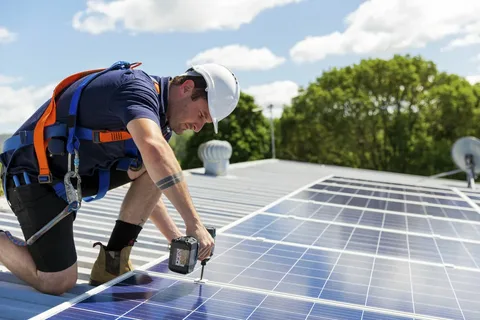Solar energy is one of the most efficient and sustainable ways to power homes and businesses. With rising electricity costs and increasing environmental awareness, more homeowners are turning to solar power as a reliable and cost-effective energy solution. Whether you want to reduce your carbon footprint, lower your energy bills, or increase your property value, solar installation offers long-term benefits.
In this guide, we will explore the benefits of solar power, the installation process, system options, maintenance tips, and cost considerations.
1. Why Choose Solar Energy?
Solar energy provides numerous advantages, making it an excellent investment for homeowners and businesses.
1.1 Cost Savings
- Significantly reduces monthly electricity bills.
- Many states offer tax credits, rebates, and incentives to lower installation costs.
- Solar panels can provide free energy for decades after installation.
1.2 Environmental Benefits
- Produces clean, renewable energy, reducing reliance on fossil fuels.
- Lowers greenhouse gas emissions, helping to combat climate change.
- Reduces air and water pollution associated with traditional energy sources.
1.3 Energy Independence
- Protects against rising electricity costs.
- Reduces reliance on the power grid, offering energy security during outages.
- Solar battery storage allows homeowners to store excess energy for later use.
1.4 Increases Property Value
- Homes with solar panels sell faster and at higher prices.
- Attracts eco-conscious buyers who value energy efficiency.
2. Types of Solar Power Systems
There are several types of solar power systems, each designed to meet different energy needs.
2.1 Grid-Tied Solar Systems
- Connected to the utility grid, allowing homeowners to use solar power and access grid electricity when needed.
- Excess energy is sent back to the grid, often earning credits through net metering programs.
- Ideal for homeowners who want to reduce their electricity bills without relying on battery storage.
2.2 Off-Grid Solar Systems
- Independent from the utility grid, requiring battery storage to provide power when the sun is not shining.
- Suitable for remote locations or homes without access to power lines.
- Higher initial investment due to the need for energy storage solutions.
2.3 Hybrid Solar Systems
- Combines solar panels, battery storage, and grid connectivity for maximum flexibility.
- Provides energy independence while allowing homeowners to draw from the grid when necessary.
- Ideal for those who want backup power during outages.
3. The Solar Installation Process
Installing a solar system involves several key steps to ensure maximum efficiency and long-term performance.
3.1 Site Assessment and Planning
- A solar professional evaluates the property’s location, roof condition, and sun exposure.
- Factors like shading, roof angle, and available space determine system size and placement.
- Energy consumption is analyzed to customize the solar panel system.
3.2 Choosing the Right Solar Panels and Equipment
- Monocrystalline Panels: Highly efficient and space-saving, best for homes with limited roof space.
- Polycrystalline Panels: Cost-effective with slightly lower efficiency, ideal for larger installations.
- Thin-Film Panels: Flexible and lightweight, suitable for unconventional mounting surfaces.
3.3 Permitting and Approvals
- Homeowners must obtain permits and approvals from local authorities and utility companies.
- Solar installation companies typically handle the paperwork to ensure compliance.
3.4 Installation of Solar Panels
- Panels are mounted on rooftops or ground-mounted systems.
- Inverters and electrical components are connected to convert solar energy into usable electricity.
- Battery storage is installed if required.
3.5 System Testing and Activation
- The system undergoes inspection and testing to ensure proper functionality.
- Once approved, the solar system is activated, allowing homeowners to start generating electricity.
4. Maintenance and Longevity of Solar Panels
Solar panels are designed for long-term durability and require minimal maintenance.
4.1 Cleaning and Inspection
- Dirt, dust, and debris can reduce efficiency, so occasional cleaning is recommended.
- Professional inspections ensure there are no loose connections or damaged components.
4.2 Monitoring System Performance
- Most solar systems come with monitoring apps to track energy production and usage.
- Monitoring allows homeowners to detect performance issues early.
4.3 Battery Maintenance (If Applicable)
- Solar batteries should be checked regularly to ensure they are holding a charge.
- Proper ventilation and temperature control extend battery lifespan.
4.4 Expected Lifespan
- Solar panels typically last 25 to 30 years with minimal efficiency loss.
- Inverters may need replacement after 10 to 15 years.
6. Solar Energy Myths and Facts
Myth: Solar Panels Do Not Work on Cloudy Days
Fact: Solar panels still generate electricity on cloudy days, though at a lower efficiency.
Myth: Solar Power is Too Expensive
Fact: Costs have dropped significantly, and incentives make solar energy more affordable than ever.
Myth: Solar Panels Require Constant Maintenance
Fact: Solar panels have no moving parts and require minimal upkeep.
Myth: Solar Installation Takes Too Long
Fact: Most residential solar installations are completed within one to three days.
7. Is Solar Installation Right for You?
Before investing in solar energy, consider the following:
- Roof Condition: Roofs should be in good condition before installing solar panels.
- Sunlight Exposure: Homes with clear access to sunlight will benefit the most.
- Energy Usage: The more electricity you use, the greater the potential savings.
- Financial Incentives: Check available rebates and tax credits to reduce costs.
Conclusion
Solar installation is a smart investment that provides long-term financial and environmental benefits. By harnessing the power of the sun, homeowners can reduce their reliance on traditional energy sources, lower electricity bills, and increase property value.
With various system options, financing opportunities, and government incentives, there has never been a better time to switch to solar energy. Ready to power your home with clean, renewable energy? Start exploring solar installation today!

